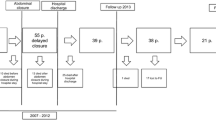Abstract
Introduction
Negative pressure therapy (NPT) is a widely recognised procedure for the temporary closure of open abdominal wounds. In this study, we compare two NPT products, the V.A.C.® abdominal dressing (AD) system and the new ABThera™ (ABT) system, in terms of the primary closure rates achieved, types of closure, and the associated morbidity.
Methods
We employed a retrospective comparative study of open-abdomen patients treated with NPT using either AD or ABT. The indications for treatment were damage control surgery, abdominal compartment syndrome, or severe abdominal sepsis.
Results
The group of patients treated with ABT showed a higher percentage of primary closures (41 vs. 11 %) and required fewer days of NPT (17 vs. 26 days) than the AD group. Differences were statistically significant. In addition, only 4 % of patients in the ABT group exhibited enteroatmospheric fistulae, compared to 17 % in the AD group.
Conclusions
Compared to the AD system, ABT can achieve faster primary closure after open abdomen treatment with only minor complications.



Similar content being viewed by others
References
Mac Lean AA, O’Keeffe T, Augnestien J (2008) Management strategies for the open abdomen: survey of the American Association for the Surgery of Trauma Membership. Acta Chir Bel 108:212–218
Cheatham JL, Safcsak K (2010) Is the evolving management of intra-abdominal hypertension and abdominal compartment syndrome improving survival? Crit Care Med 38:402–407
Regner JL, Kobayashi L, Coimbra R (2012) Surgical strategies for management of the open abdomen. World J Surg 36:497–510
Carlson GL, Patrick H, Amin AI, McPherson G, MacLennan G, Afolabi E, Mowatt G, Campbell B (2013) Management of the open abdomen: a national study of clinical outcome and safety of negative pressure wound therapy. Ann Surg 257:1154–1159
Cheatham M, Demetriades D, Fabian T, Kaplan M, Miles W, Schreiber M, Holcomb J, Bochicchio G, Sarani B, Rotondo M (2013) Prospective study examining clinical outcomes associated with a negative pressure wound therapy system and Barker vacuum packing technique. World J Surg 37:2018–2030
Caro A, Olona C, Jiménez A, Vadillo J, Feliu F, Vicente V (2001) Treatment of the open abdomen with topical negative pressure therapy: a retrospective study of 46 cases. Int Wound J 8:274–279
Licheri S, Erdas E, Pisano G, Garau A, Ghinami E, Pomata M (2008) Chevrel technique for midline incisional hernia: still an effective procedure. Hernia 12:121–126
De Oliveira ML, Winter JM, Schafer M, Cunningham SC, Cameron JL, Yeo CJ (2006) Assessment of complications after pancreatic surgery: a novel grading system applied to 633 patients undergoing pancreaticoduodenectomy. Ann Surg 2446:931–937
Navsaria P, Nicol A, Hudson D, Cockwill J, Smith J (2013) Negative pressure wound therapy management of the “open abdomen” following trauma: a prospective study and systematic review. World J Emerg Surg 8:4–8
Biondo S (2012) Damage control surgery in non-traumatic abdominal emergencies. Cir Esp 90:345–347
Boele P, Wind J, Dijkgraaf MG, Busch OE, Goslings JC (2009) Temporary closure of the open abdomen: a systematic review on delayed primary fascial closure in patients with an open abdomen. World J Surg 33:199–207
Cheatham ML, Malbrain MLNG, Kirkpatrick A, Sugrue M, Parr M, De Waele J, Balogh Z, Leppaniemi A, Olivera C, Ivatury R, D’Amours S, Wendon J, Hillman K, Wilmer A (2007) Results from the international conference of experts on intra-abdominal hypertension and abdominal compartment syndrome II. Recomm Intensiv Care Med 33:951–962
Barker DE, Kaufman HJ, Smith LA (2000) Vacuum pack technique of temporary abdominal closure: a 7-year experience with 112 patients. J Trauma 48:201–207
Lindstedt S, Malmsjo M, Hlebowicz J, Ingemansson R (2013) Comparative study of the microvascular blood flow in the intestinal wall, wound contraction and fluid evacuation during negative pressure wound therapy in laparostomy using he VAC abdominal dressing and the ABThera open abdomen negative pressure therapy system. Int Wound J. doi:10.1111/iwj.12056
Perez D, Wildi S, Demaritnes N (2007) Prospective evaluation of vacuum-assisted closure in abdominal compartment syndrome and severe abdominal sepsis. J Am Coll Surg 205:586–592
Pliakos Ioannis, Papavramidis T, Michalopoulos N, Deligiannidis N, Kesisoglou I, Sapalidis K, Papavramidis S (2012) The value of vacuum-assisted closure in septic patients treated with laparostomy. Am Surg 78:957–961
Petersson U, Acosta S, Byörck M (2007) Vacuum-assisted wound closure and mesh-mediated fascial traction—a novel technique for late closure of the open abdomen. World J Surg 31:2133–2137
Fortelny RH, Hofmann A, Gruber-Blum S, Petter-Puchner AH, Glaser K (2013) Delayed closure of open abdomen in septic patients is facilitated by combined negative pressure wound therapy and dynamic fascial suture. Surg Endosc. doi:10.1007/s00464-013-3251-6
Rao M, Burke D, Finan PJ, Sagar PM (2007) The use of vacuum-assisted closure of abdominal wounds: a word of caution. Colorectal Dis 9:266–268
Bjarnason T, Montgomery A, Hlebowicz J, Lindstedt S, Peterson U (2011) Pressure at the bowel surface during topical negative pressure therapy of the open abdomen: an experimental study in a Porcine model. World J Surg 35:917–923
Acknowledgments
We are grateful to the all members of the General and Digestive Surgery Department for their collaboration, to the Statistical Service of the IISPV for the statistical analysis, and to the language service of the Rovira i Virgili University for translating our original text. This study has not received any form of funding and the authors of this article do not have any commercial interest.
Conflict of interest
C.O. declares no conflict of interest. A.C. declares no conflict of interest. E.D. declares no conflict of interest. F.M. declares no conflict of interest. JC. R. declares no conflict of interest. J.V. declares no conflict of interest. V.V. declares no conflict of interest.
Author information
Authors and Affiliations
Corresponding author
Rights and permissions
About this article
Cite this article
Olona, C., Caro, A., Duque, E. et al. Comparative study of open abdomen treatment: ABThera™ vs. abdominal dressing™. Hernia 19, 323–328 (2015). https://doi.org/10.1007/s10029-014-1253-5
Received:
Accepted:
Published:
Issue Date:
DOI: https://doi.org/10.1007/s10029-014-1253-5




